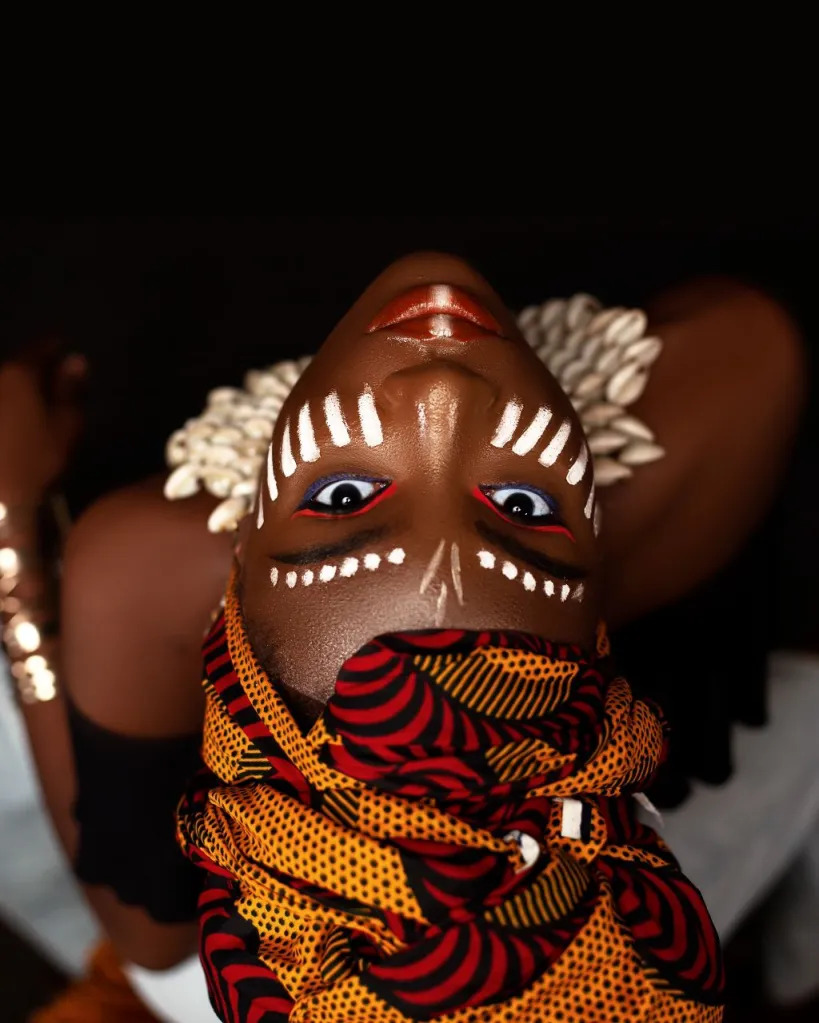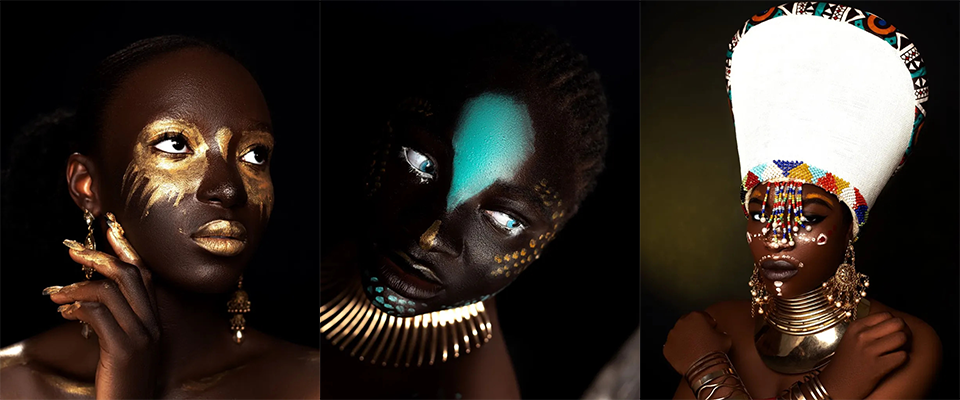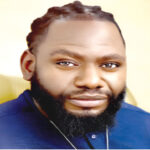Echoes of the Ancestors; a turquoise goddess distracted by her grievance. The photograph is riveting but also unsettling; you can feel her itch to break loose of the frozen pose her frame keeps her in. You can immediately sense fast tempo scenes unfolding beyond her line of sight.
Samuel Oladele says he intended to present ‘the unique African way of looking’ in Echoes of the Ancestors, as well as the rest of the series Spirituality and Face Painting.
He has always paid intense attention to the philosophy behind vision – a quality which in retrospect spot-lit his gift as a photographer even before he fully realized it.
Before turning fully to photography, Oladele had worked in Nigeria as a used car salesman, during which he was fixated on the stories the cars carried behind their seats and in the corners of refurbished bodies, in how second-rate cars transformed to status symbols under Nigerian eyes.
Learning about life through cars was a smooth ride, but it failed to ‘ignite his soul’. Soon Samuel started seriously taking pictures.
Samuel Oladele, now living in Manchester, continues to project his Yoruba and African heritage in artful photography, in series and exhibitions.
His series on spirituality and face painting has received high praise since its debut in 2024. It has been admired in galleries from Enugu to Athens to the Holy Art Gallery in the UK. It is a cinematic visual essay, most frames are evocative and bleed with symbolism.
The series has attracted critical attention as well, Chinonso Ihekire writes of it in The Guardian, saying it ‘aims to challenge stereotypes, celebrate African cultural heritage, and foster cross-cultural understanding.’ While Oladele certainly challenges technical stereotypes such as desaturation as a default expression of grief, much is to be said about his faithfulness to essence.
First spread; an upside-down portrait and the woman in it is calling at you with an intense stare. Oladele is always happy to come at you unawares with his angles and I find that a most arresting feature of his art.
The white markings echo patterns from West African traditions—like Yoruba ori or Igbo uli face painting—but they don’t exactly quote them. There’s theatricality here, a kind of fashion-forward abstraction. Oladele’s background in commercial photography is self-apparent in his artistic work, and as we would soon see, plays out as a double-edged sword.
Paired with cowries (symbols of wealth, divination, and femininity across many cultures), the image plays with recognizable emblems. But it’s less priestess, more editorial oracle.
The next three images lean even further into cultural vagueness. With the second (the most loved of this series), gold, obviously, invokes royalty, divinity. Oladele paints her not just with gold, but almost as gold- a being of illumination.
The third turquoise frame suggests either god-spirits; ancestors or water deities- Yemoja? Mami wata? But again, not literally. The contact lenses, the constellation of painted dots referencing East African tribes, the glowing skin- they remix spiritualism through a surreal lens; pop Afro-futurism.
Pop in that the photographer borrows well-known spiritual codes from multiple sources, refusing to speak any dialect fluently. There is a flaw in this attitude on two levels.
First, it flattens rich, rooted traditions into interchangeable symbols- cowries, paint- without context or commitment; second it assumes African spirituality to be an accessorial aesthetic, collapsing the weight of belief into visuals meant to impress, not invoke.
This is hardly different from the European attitude to African cultural modes- patronizing fascination, studying only to appropriate in shallow, sometimes insulting ways.
The goal in both mindsets is the same; to turn a lifestyle (especially one the artist does not practice) into aesthetic, to reduce cultures in the Global South to iconography and myth mixed in fiction inspired by mass media – I refer to the Wakanda hand gesture in the fourth image (which might interest you to learn does not exist anywhere in Africa or African spirituality).
On the first level, the defense counsel is already crying out objection. It would readily spotlight Nigerian essayist and photographer Teju Cole’s thoughts on cultural heritage expressed in Black Body, that everyone is allowed to enjoy and repurpose all in the name of art, since beyond tribe and environment, everything is connected by the fact that all are expressions of fundamental, common human experiences.
As Teju Cole extrapolates; ‘Bach, so profoundly human, is my heritage. I am not an interloper when I look at a Rembrandt portrait.’ Hence, zero fuss should be raised if a photo-artist decides to pour the most identifiable face painting symbols from Xhosa and Yoruba societies into a Bunsen burner swirling with Ankara textile and symbolic stereotypes- especially when the result is a bold modernist re-imagining; aesthetic stances I would be delighted to find inspiring real-life fashion tastes.
I am more suspicious about the intent behind the work than its outcome. Is the vagueness the point? If that were the case we would be discussing how it pushes boundaries on our perception of the place of African material culture in a globalized present.
But it would be hard to conclude so, as reviewers and even the title of the series itself insist on framing it as representation, rather than reaction or even a work in another genre that references sacred symbology. Is Ilorin-born Manchester-based Samuel Oladele diluting his sources to make his work more ‘accessible’ to European audiences? He certainly can’t plead to be ignorant of the depth and richness of the tradition he represents.
Perhaps his career in commercial photography and attendant desire for every frame to sell may be blamed for beating the evocation of this series to a barely relatable motif. Because Oladele can create near-perfect compositions, as he proved in Inferno Dance, another series paying homage to African fire-eating dance. Body art traditions, such as ori, function as heavily compressed languages; each shape, line and color tells a profound story.
Stared at long enough, you would come away with an expansive narrative that bares truths about the worldview and value system of the represented culture. Art historian Rowlad Abiodun insists in Yoruba Art and Language: Seeking the African in African Art, ‘the visual is always in dialogue with the verbal, the spiritual and the performative.’
And elsewhere in the book, ‘to interpret Yoruba art only through a Western lens of form and style is to miss its inner language entirely.’ The Yoruba hold the belief that everyone chooses their destiny (ori) before birth. Your chosen life path becomes your spiritual compass, and fate in the visible world. Adorning the head (same word in Yoruba) and face with symbols is a recognition of this life contract. Face painting becomes a way to harmonize the external self with spirit. Cue in Oladele’s Spirituality and Face Painting; Do you see any stories?
It is difficult to find a good excuse for the dissatisfaction this appraising leaves us with. Diluting for White accessibility? There are clouds of artists to readily wash away notions that Africans need to compromise on artistic fidelity to secure patronage elsewhere.
Fellow Ilorin native Laolu Senbanjo made a mark creating body paint and textiles that vividly platforms Yoruba norms and philosophy, (for Western commissioned projects he appears to bounce within that space between authentic and symbolic common with Black American artists trying to ‘return to the roots’). Jelili Atiku is another artist whose dogged, confrontational insistence on substance can be pointed to; his aura is almost Fela-like.
In one of his performances, he breaks a museum vase to extract an Yoruba deity, then douses it in Schnapps and incantations. The acceptable stance is crystal. In light of 21st century African cultural awakening, side by side with the near-extinction of art and writing systems displaced by colonialism, repackaging (or worse, simplifying) your spirituality/culture for foreign audiences is not only branding wisdom born from a feeling of inferiority, it is ethically irresponsible.
Rowland Abiodun’s words come to instruct again; ‘Art, for the Yoruba, is not a separate sphere of life. It is life…’ Art in the globalized present, may borrow, remix, re imagine- but when it comes to sacred forms fixed in antiquity, one hopes it also remembers to study and listen. In the end, what Oladele offers is a vision – lush, animated, expertly lit- but it is a vision that speaks about African spirituality, not with it.
Ebri Kowaki is a culture journalist and Afrofusion commentator. His works have appeared in The Republic, Afrocritik, African Writer Magazine, Akowdee Magazine, and elsewhere. A 2025 fellow of the Ebedi International Writers Residency, he was shortlisted for the Ikenga Prize in 2024.







